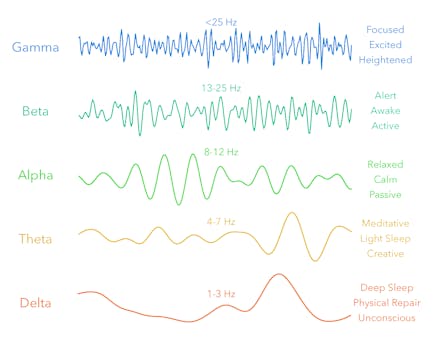Unlocking the Power of Brainwaves: A Journey to Enhance Creativity, Focus, and Well-Being
Terms of Service
Privacy Policy
Etiam gravida nibh hendrerit diam rhoncus congue. Pellentesque ut eros nec nisi tempor mattis nec ac diam. Pellentesque eget risus sagittis, laoreet lorem a, porta est. Ut dui metus, ullamcorper id sem non, consectetur vulputate nisi. Aliquam id placerat ipsum.
Copyright © Company Name
How Tuning Into Your Brain's Rhythms Can Transform Your Mind and Life
In the vast and intricate world of neuroscience, brainwaves stand out as a captivating phenomenon that offers profound insights into our mental states and cognitive processes. These electrical impulses, generated by the synchronized activity of neurons, reveal much about how we think, feel, and interact with the world around us. Understanding brainwaves is not just a scientific endeavor; it holds practical implications for enhancing mental health, boosting creativity, and improving overall well-being.
In this article, we will embark on a journey to explore the five main types of brainwaves: Delta, Theta, Alpha, Beta, and Gamma. Each day, we will delve into one type, uncovering its unique characteristics, the states of consciousness it represents, and practical ways to access and harness its potential.

Understanding Brainwaves
Before we dive into the specifics of each brainwave type, it's essential to grasp the fundamental concept of brainwaves. Brainwaves are the rhythmic oscillations of electrical activity in the brain, measured in Hertz (Hz), or cycles per second. These waves are detected using an electroencephalogram (EEG), a tool that provides a window into the brain's dynamic activity.
Brainwaves are categorized based on their frequency, with each category corresponding to different states of consciousness and mental activities. The frequency range of brainwaves spans from the slow, deep rhythms of Delta waves to the fast, high-frequency Gamma waves. Each type of brainwave plays a crucial role in our cognitive and emotional functioning, influencing everything from sleep and relaxation to concentration and problem-solving.
As we explore each brainwave type over the coming days, we'll gain a deeper understanding of how these patterns impact our daily lives and how we can intentionally access them to enhance our mental and emotional well-being. Stay tuned as we embark on this enlightening exploration of the human mind.
The Five Main Types of Brainwaves
1. Delta Waves (0.5-4 Hz): Delta waves are the slowest brainwaves, typically associated with deep, restorative sleep. They are crucial for healing and regeneration, both physically and mentally. When Delta waves dominate, the body is in a state of deep rest, allowing for recovery and rejuvenation. Accessing Delta waves can be achieved through practices that promote deep sleep, such as maintaining a regular sleep schedule and creating a calming bedtime routine.
2. Theta Waves (4-8 Hz): Theta waves are linked to creativity, intuition, and relaxation. They often occur during light sleep and deep meditation, providing a bridge between the conscious and subconscious mind. Theta waves are associated with vivid imagery, dream states, and the flow of ideas. Techniques such as meditation, deep relaxation, and visualization can help access Theta waves, enhancing creativity and insight.
3. Alpha Waves (8-12 Hz): Alpha waves are present during states of relaxed alertness and calm focus. They are often experienced during moments of quiet reflection or when the mind is at ease. Alpha waves promote mental coordination, calmness, and learning. Activities like mindfulness, yoga, and light meditation can help increase Alpha wave activity, fostering a state of relaxed awareness.
4. Beta Waves (12-30 Hz): Beta waves are associated with active thinking, problem-solving, and focus. They are prevalent when we are engaged in tasks that require concentration and alertness. While essential for cognitive functioning, excessive Beta wave activity can lead to stress and anxiety. Accessing Beta waves involves engaging in activities that require mental effort and focus, such as studying or solving complex problems.
5. Gamma Waves (30 Hz and above): Gamma waves are the fastest brainwaves, linked to high-level information processing and cognitive functioning. They are involved in activities that require intense concentration and are thought to play a role in the integration of information across different brain regions. Advanced meditation practices and cognitive exercises can help access Gamma waves, enhancing mental clarity and cognitive performance.
Each of these brainwave types offers unique benefits and can be accessed through specific practices and activities. Let's explore each brainwave in more detail, providing insights into how you can harness their potential to improve your mental and emotional well-being. Stay tuned for an in-depth look at each of these fascinating brainwave patterns.

William James, Philosopher and Psychologist
The greatest weapon against stress is our ability to choose one thought over another.
Practical Applications
Understanding and harnessing the power of brainwaves can have profound implications for various aspects of our lives. By intentionally accessing different brainwave patterns, we can enhance our cognitive abilities, emotional well-being, and overall quality of life. Here are some practical applications of brainwave knowledge:
Enhancing Learning and Memory:
Alpha and Theta waves are particularly beneficial for learning and memory retention. By engaging in activities that promote these brainwave states, such as meditation and mindfulness, we can improve our ability to absorb and recall information. Techniques like visualization and mental rehearsal can also enhance memory by activating Theta waves.
Boosting Creativity and Problem-Solving:
Theta and Gamma waves are associated with creativity and innovative thinking. Practices that encourage these brainwave states, such as brainstorming sessions, free writing, and creative visualization, can lead to breakthroughs in problem-solving and artistic expression. Engaging in activities that stimulate the imagination can help tap into these creative brainwave patterns.
Improving Focus and Productivity:
Beta waves are essential for maintaining focus and productivity. By creating an environment that minimizes distractions and promotes concentration, we can enhance Beta wave activity. Techniques such as the Pomodoro Technique, which involves working in focused bursts with short breaks, can help sustain attention and increase productivity.
Reducing Stress and Enhancing Relaxation:
Alpha and Delta waves play a crucial role in relaxation and stress reduction. Practices like deep breathing, progressive muscle relaxation, and guided imagery can help increase these brainwave states, promoting a sense of calm and well-being. Regularly engaging in relaxation techniques can reduce stress levels and improve overall mental health.
Promoting Emotional Regulation and Well-Being:
Understanding brainwaves can aid in emotional regulation by helping us recognize and shift our mental states. Techniques such as mindfulness meditation and cognitive-behavioral strategies can help manage emotions by promoting Alpha and Theta wave activity. By cultivating awareness of our brainwave patterns, we can develop greater emotional resilience and balance.
WANT TO READ MORE INTERESTING ARTICLES LIKE THIS?
Join my newsletter to keep updated on all my newest hints and tricks.

In Conclusion
Integrating brainwave practices into daily life can lead to significant improvements in mental and emotional well-being. By consciously accessing different brainwave states, we can unlock our full potential and enhance our overall quality of life. As we continue to explore each brainwave type in detail, you'll discover more ways to apply this knowledge for personal growth and development.





